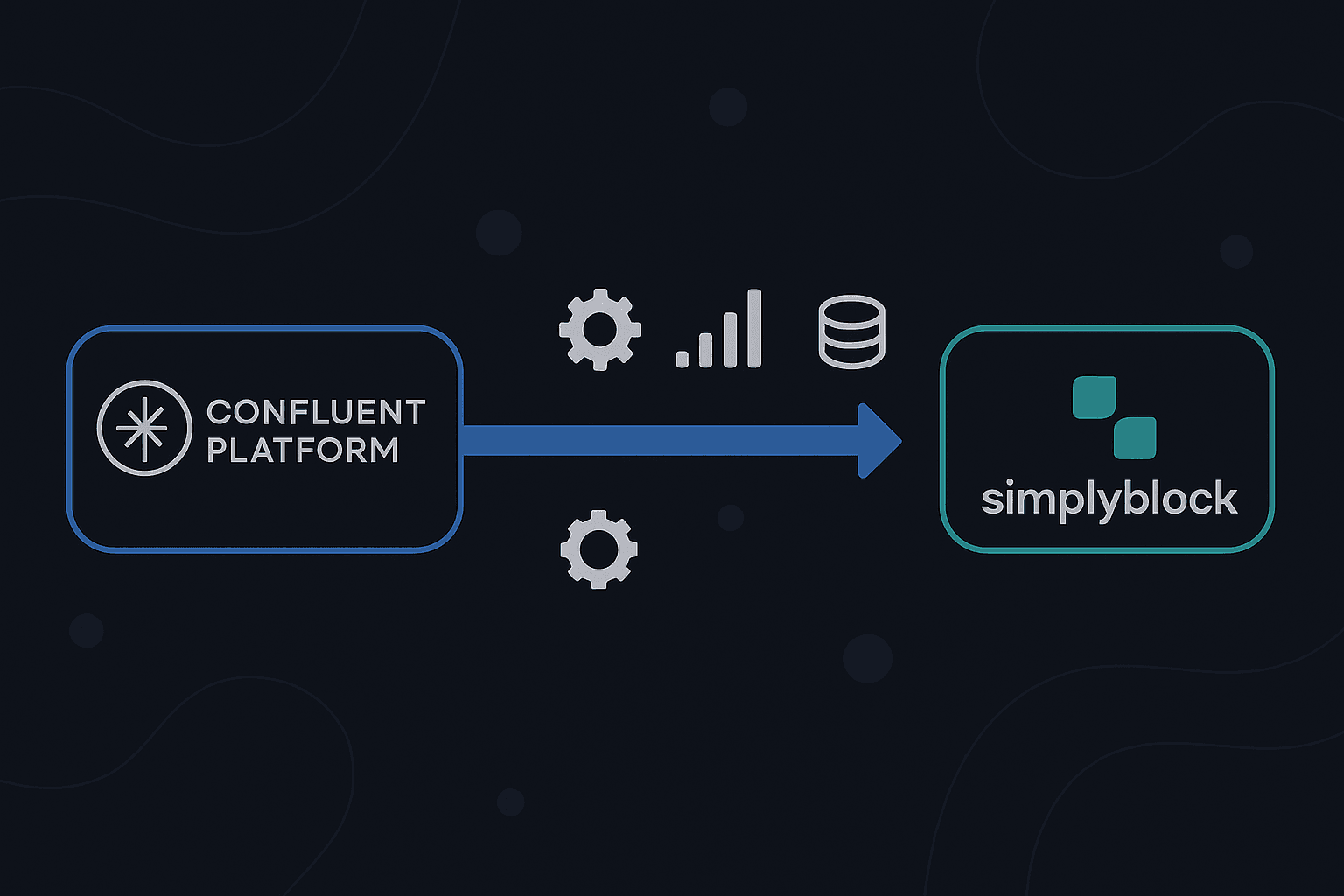Confluent Platform extends Apache Kafka into an enterprise-grade streaming solution with added tools like schema registry, ksqlDB, connectors, and Control Center. These enhancements make real-time data pipelines easier to manage at scale, but they also increase reliance on persistent storage. From broker logs to metadata and stateful workloads, storage performance directly impacts cluster efficiency.
Simplyblock delivers the speed and resilience Confluent clusters need. By providing low-latency, zone-independent volumes that scale on demand, it ensures consistent performance for streaming workloads without the bottlenecks of traditional storage.
Why Storage Matters for Confluent Platform
At its core, Confluent Platform depends on Kafka brokers continuously writing logs to disk. Beyond that, schema registry, connectors, and ksqlDB add metadata and state storage requirements. If the persistence layer is too slow or limited to a single zone, cluster performance suffers and scaling becomes painful.
Simplyblock addresses this by enabling high-throughput storage that replicates across zones and grows seamlessly. This ensures Confluent clusters maintain responsiveness, even as message volumes and streaming workloads increase.
🚀 Strengthen Confluent Platform with Simplyblock
Keep Confluent clusters consistent, durable, and fast for enterprise-scale streaming.
👉 See how simplyblock supports software-defined storage
Step 1: Setting Up Simplyblock Volumes for Confluent
Start by preparing volumes for Confluent broker logs and supporting services. Using the CLI:
sbctl pool create confluent-pool /dev/nvme0n1
sbctl volume add confluent-logs 1T confluent-pool
sbctl volume connect confluent-logs
Format and mount the volume:
mkfs.ext4 /dev/nvme0n1
mkdir -p /confluent/logs
mount /dev/nvme0n1 /confluent/logs
More details on setup are available in the simplyblock documentation.

Step 2: Configure Confluent Platform with Simplyblock
Update broker configuration (server.properties) to point logs to the simplyblock-backed path:
log.dirs=/confluent/logs
num.partitions=8
log.segment.bytes=1073741824
Restart brokers, and logs will now persist on simplyblock volumes. For additional services like schema registry or Control Center, adjust configuration paths as needed. Full details are in the Confluent Platform configuration guide.
Step 3: Validating Confluent + Simplyblock
Verify the cluster is running and persisting data:
confluent status
On the storage side, check performance with:
sbctl stats
This dual check confirms both Kafka-level operations and storage performance. For environments running on Kubernetes, this approach complements Kubernetes backup strategies by keeping metadata safe.
Step 4: Scaling Confluent Platform Storage
As event streams grow, so do storage needs. With simplyblock, resizing volumes is seamless and doesn’t interrupt cluster operations:
sbctl volume resize confluent-logs 2T
resize2fs /dev/nvme0n1
This ensures Confluent clusters can expand capacity without downtime. It’s particularly useful for enterprises integrating with VMware storage, where elasticity is critical.
Step 5: Performance Tuning & Best Practices
To maximize throughput, spread Kafka partitions across multiple simplyblock volumes and tune flush intervals to match workload demands. Monitoring should include both Confluent metrics and storage-level stats:
iostat
sbctl stats
For advanced observability, use Control Center to track broker health and throughput. The Confluent Control Center documentation provides details on dashboards and metrics. These optimizations also align with optimizing Kubernetes costs when Confluent is deployed in containerized environments.
Ensuring Durability in Confluent Platform with Simplyblock
High availability in Confluent clusters relies on replication across brokers, but durability is only as strong as the underlying storage. If a zone goes down, losing logs and state data can stall critical pipelines.
Simplyblock strengthens durability by replicating volumes across availability zones. Broker logs, schema registry data, and ksqlDB states remain intact, ensuring clusters recover quickly during failures. For enterprises running mission-critical pipelines, this is further supported by disaggregated storage architectures that separate compute from storage for added flexibility.
Questions and Answers
Confluent Platform relies on Apache Kafka for streaming, where disk throughput is often the bottleneck. By running brokers on simplyblock NVMe over TCP volumes, throughput improves significantly as writes and log segment compactions complete faster, reducing producer lag and improving consumer performance.
Yes, simplyblock consolidates Kafka broker volumes and automates tiering for long-lived data. With cloud storage cost optimization, Confluent clusters can scale efficiently without overprovisioning, lowering infrastructure costs while maintaining high throughput.
Replication between Kafka brokers in Confluent clusters can create I/O bottlenecks. Simplyblock’s elastic NVMe-backed storage accelerates replication, ensuring durability and reducing ISR (in-sync replica) lag. This keeps Confluent clusters stable under heavy streaming loads.
Yes, Confluent Platform on Kubernetes benefits from simplyblock’s NVMe-TCP integration, which provides high-performance persistent volumes. This ensures that stateful components like Kafka brokers and Schema Registry achieve predictable performance with dynamic scaling.
To deploy Confluent Platform with simplyblock, attach NVMe-TCP volumes to broker nodes or define a Kubernetes StorageClass for dynamic provisioning. Simplyblock manages replication, snapshots, and encryption, simplifying operations while ensuring high throughput and resilience for streaming data pipelines.

